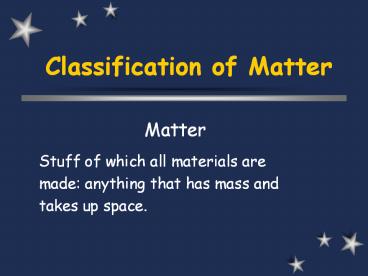Classification of Matter - PowerPoint PPT Presentation
Title:
Classification of Matter
Description:
Classification of Matter Matter Stuff of which all materials are made: anything that has mass and takes up space. Define Atoms- Extremely small building blocks of ... – PowerPoint PPT presentation
Number of Views:204
Avg rating:3.0/5.0
Title: Classification of Matter
1
Classification of Matter
- Matter
- Stuff of which all materials are made anything
that has mass and takes up space.
2
Define
- Atoms- Extremely small building blocks of matter
- All matter is composed of atoms
- Atoms cannot be broken down into smaller pieces
by chemical means - The smallest distinct units in a sample of matter
- Elements are made up the same atoms.
- Elements cannot be decomposed into other
substances.
3
B. Pure Substances
- Element
- composed of identical atoms
- EX copper wire, aluminum foil
4
Define
- Molecule a combination of 2 0r more atoms (same
or different) that are covalently bonded. - A molecule is the smallest particle of a
substance which exhibits the physical and
chemical characteristics of the substance. - Diatomic molecules of elements
- H2 O2 Cl2 N2 F2 Br2 I2
5
Define
- Compounds a compound of 2 or more different
elements bonded together in a fixed proportion.
- H2O CO2
- CaSO4 HBR
- Na2O KOH
- H2 CO3
Molecules
6
B. Pure Substances
- Compound
- composed of 2 or more elements in a fixed ratio
- properties differ from those of individual
elements - EX table salt (NaCl)
7
B. Pure Substances
- For example
Two different compounds, each has a definite
composition.
8
Compounds
- Slight differences in combinations of atoms can
have large difference in properties - H2O- water,
- H2O2 hydrogen peroxide
- C2 H6O ethanol, drinkable
- C2 H6O2 ethylene glycol, poisonous
9
Compounds
- Law of Definite Composition
- A given compound always contains the same, fixed
ratio of elements. - Law of Multiple Proportions
- Elements can combine in different ratios to form
different compounds.
10
Pure Substances
Same kind of particles throughout
- Compounds
- Can be decomposed into simpler substances by
chemical changes, always in a definite ration
- Elements
- cannot be decomposed into simpler substances by
chemical changes
11
Mixture
- Mixtures are two or more substance that are not
chemically combined. - Mixtures do not have a fixed composition
- Mixtures do not have constant boiling points or
melting points - Variable composition
- Components retain their characteristic properties
12
Mixture
- May be separated into pure substances by physical
methods - Mixtures of different compositions may have
widely different properties.
13
- Pure Substances and Mixtures
14
Which is it?
15
Physical Separation Techniques
- By eye
- Filtration to separate solid and liquid
- Distillation to separate two or more liquids with
different boiling points - Chromatography to separate pure liquids or
solutions of compounds
16
C. Mixtures
- Variable combination of 2 or more pure substances.
Heterogeneous
Homogeneous
17
(No Transcript)
18
(No Transcript)
19
Types of mixtures
- Homogeneous mixture
- -1 phase
- -uniform properties in a sample
- -same composition in a sample
- eg sugar and water
- Heterogeneous mixture
- -2 or more phases (with same or different
physical states) - -each phase has different properties
- eg oil and water, sand and water
20
A. Matter Flowchart
MATTER
yes
no
Can it be physically separated?
Homogeneous Mixture (solution)
Heterogeneous Mixture
Compound
Element
21
C. Mixtures
- Solution
- homogeneous
- very small particles
- no Tyndall effect
- particles dont settle
- EX rubbing alcohol
22
C. Mixtures
- Colloid
- heterogeneous
- medium-sized particles
- Tyndall effect
- particles dont settle
- EX milk
23
C. Mixtures
- Suspension
- heterogeneous
- large particles
- Tyndall effect
- particles settle
- EX fresh-squeezed lemonade
24
C. Mixtures
- Examples
- mayonnaise
- muddy water
- fog
- saltwater
- Italian salad dressing
- colloid
- suspension
- colloid
- solution
- suspension
25
A. Matter Flowchart
- Examples
- graphite
- pepper
- sugar (sucrose)
- paint
- soda
- element
- hetero. mixture
- compound
- hetero. mixture
- solution
26
Classifying Matter
27
The Atomic-Molecular Theory of MatterA
microscopic view
28
PRACTICE PROBLEMS 4
- 1. Classify the following as an element,
compound, or mixture (heterogeneous or
homogeneous). - _____ air _____ oxygen
- _____ tin can _____ sugar
- _____ Windex _____ crude oil
- _____ suntan lotion _____ gummi bear
- 2. A white solid is dissolved in water. The
resulting colorless, clear liquid is boiled in a
beaker until dryness. White crystals remain in
the beaker. The liquid can be classified as
a(n) ______________. - 3. Classify the following as physical or
chemical changes. - _____ photosynthesis _____ baking
- _____ writing with pencil _____ snowing
E
HO
E
C
HO
HE
HO
HE
Homogeneous mixture
CC
CC
PC
PC
29
GROUP STUDY PROBLEM 4
- 1. Classify the following as an element,
compound, or mixture (heterogeneous or
homogeneous). - _____ wine _____ root beer
- _____ penny _____ table salt
- _____ Bleach _____ wood
- _____ diamond _____ vinegar
- 2. A clear blue liquid in an open beaker was
left in the hood. After 1 week, the beaker
contained only blue crystals. The original
liquid can be classified as a(n)
______________. - 3. Classify the following as physical or
chemical changes. - _____ perspiration _____ sugar dissolving
- _____ fermentation _____ aging































